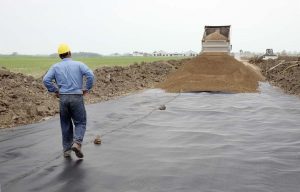Woven geotextile fabrics are manufactured through traditional weaving of individual threads into sizeable sheets. Individual threads are made of different kinds of materials, ranging from fibrillated yarns to monofilaments, slit films, etc. They are woven together on a specialized loom to create a large, uniform piece or sheet of geotextile material. Because of this process, woven geotextiles offer much higher load capacities, making them ideal for heavy-duty applications such as road construction. However, weaving together films or threads create a not-so-porous surface, making woven geotextiles a poor fit for drainage projects. Just the same, their nonporous structure makes them ideal for certain erosion control projects wherein water must be led or passed over the surface, while preventing it from draining through the soil below. Other ideal characteristics of woven geotextiles include corrosion resistance and long-term durability.
Nonwoven geotextiles on the other hand, are produced by bonding, instead of weaving, materials together. This is done either with the use of chemicals or heat, or through other methods like needlepunching. These nonwoven fabrics are typically made of synthetic materials and are widely used in separation and filtering applications. Unlike their woven counterparts, nonwoven fabrics aren’t as good a fit for reinforcement and stabilization projects, although they are a better choice for special uses like the protection of geomembrane lining systems against exterior or interior penetrations.
Nonwoven geotextiles break down much faster than woven geotextiles because they don’t have the same reinforced strength as layers of material woven together have. However, where pooling or standing water is a problem, nonwoven geotextiles offer a better choice in the management of such issues. Nevertheless, nonwoven fabrics still offer good durability and strength on top of great drainage properties, making them suitable for a range of applications.

This article first appeared on the Winfab USA blog, www.winfabusa.com/news.
 TEXTILES.ORG
TEXTILES.ORG


